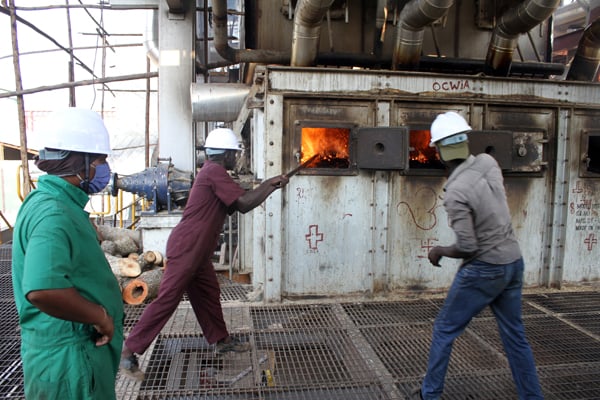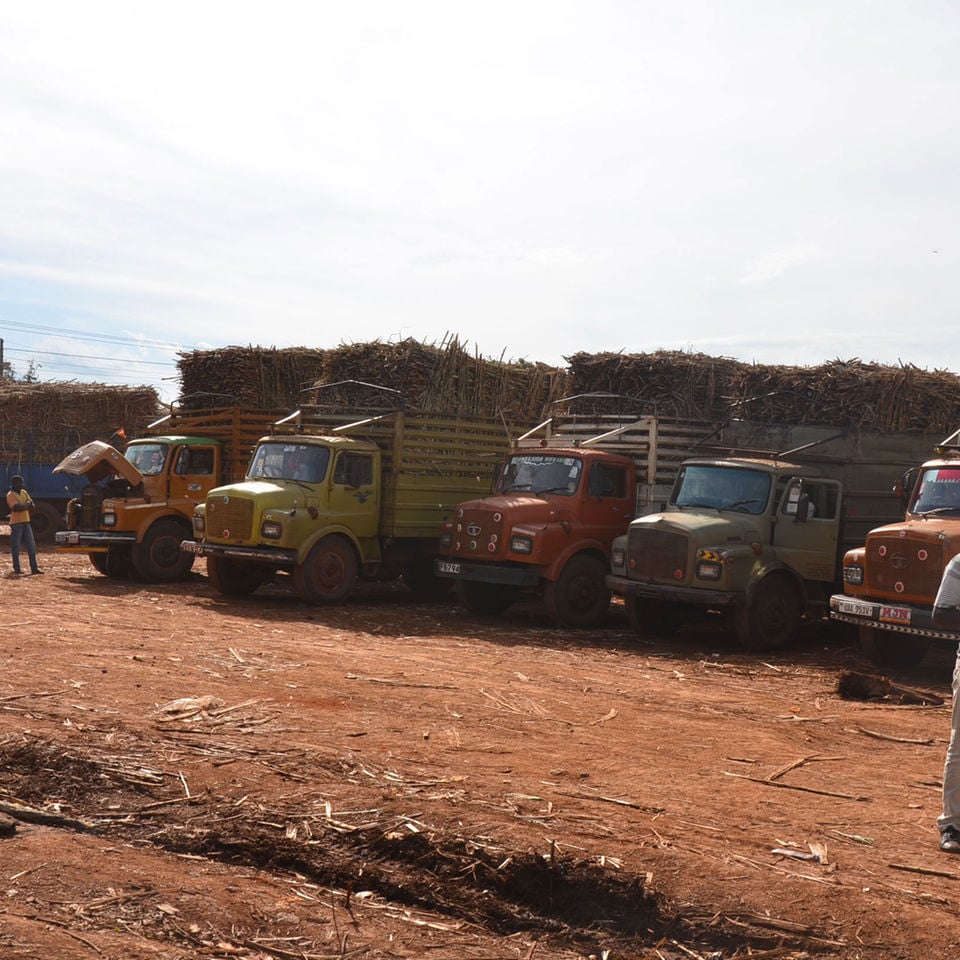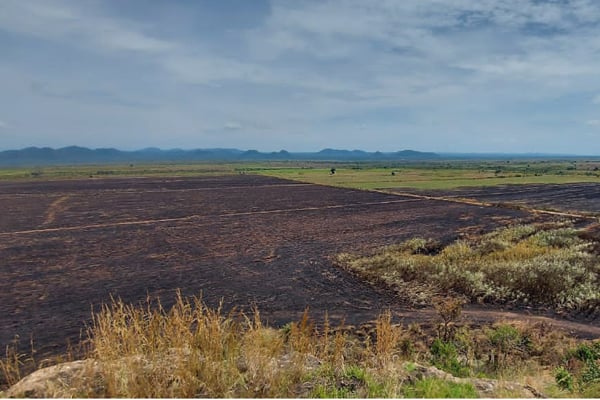Prime
Billions of shillings later, Atiak Sugar wobbles on

Workers feed fuel into a furnace at Atiak Sugar Factory in May 2021. PHOTO/ TOBBIAS JOLLY OWINY
What you need to know:
- Atiak Sugar Factory—located at Gem Village in Pachilo Parish in Atiak Sub-county in Amuru District—is jointly owned by the government and Horyal Investment Holdings Company Ltd.
A parliamentary directive to the Auditor General to institute a value-for-money audit into Atiak Sugar Ltd looks set to push the company further down the abyss after it suspended operations due to lack of raw materials early this year.
House Speaker Anita Among directed Auditor General John Muwanga a fortnight ago to scrutinise the vast sums of government money pumped into the Atiak Sugar factory.
Ms Among directed that the audit establishes “how many shares we have” and “what rights we have.”
“How is the corporate governance in such institutions and do we have any voting rights, anyway?” the Speaker wondered.
Ms Among’s directive—made in line with Section 31 of the Public-Private Partnership Act, 2015—is part of the strings of measures intended to hold recipients of government bailouts accountable.
Atiak Sugar Factory—located at Gem Village in Pachilo Parish in Atiak Sub-county in Amuru District—is jointly owned by the government and Horyal Investment Holdings Company Ltd. The latter belongs to Dr Amina Hersi Moghe.
Located 17km north of Atiak, off the Gulu-Nimule Road, in Gem Village, Pachilo Parish, Atiak Sub-county in Amuru District, the factory is the first major investment in the region. Lawmakers have, however, continued to question why the government’s stakes in it have remained significantly low compared to those of Horyal Investments. This, they add, is despite the huge capital the former has injected into the venture in the past years.
Last September, the House Committee on Trade questioned why the government—the lowest shareholder in Atiak Sugar Limited—continues to invest the most money in the factory. The committee also called into question the circumstances under which Naads contracted the company to clear, plant, and harvest sugarcane valued at Shs54 billion instead of working directly with the out-growers.
Atiak stops sugar production
Later in November last year, the parliamentary Budget Committee threw out the government’s supplementary request of Shs108b. Junior Trade State minister David Bahati had revealed that the subvention was meant to scale-up work at the sugar factory.
The legislators declined to endorse Dr Hersi’s request to the government, citing absence of proof that her investment was making a substantial contribution to the economy. They instead demanded a forensic audit into how she has spent more than Shs120b received from the government.
At the time of the request, Mr Patrick Birungi—the executive director of the Uganda Development Cooperation (UDC)—reasoned that the money was meant to rejuvenate and, or trigger a larger scale of work at the multi-billion factory. Mr Birungi particularly revealed that the money would be committed to mechanising works at Atiak.
Early this year, the decision was revised and the Shs108b request was approved despite the government’s shareholding in the plant stagnating at 40 percent.
Saturday Monitor understands that similar financial requests were made by the Atiak Sugar leadership to the 10th Parliament. While most of them were rejected, it later emerged that they were granted.
Production lull
Regardless of the number of shares held by the said parties, the government is said to have spent a dizzying at least Shs290b on the sugar facility compared to Horyal Investments Holding Company Limited’s Shs120b. Yet production of sugar at the factory has just started after a two-year hiatus as per the National Agricultural Advisory Services (Naads).
Mr Jackson Hamilton Ogwang, the Naads zonal agricultural development officer-in-charge of the Acholi Sub-region, told Saturday Monitor in an interview that the decision to suspend production was based on grounds that there is no cane to run the plant. Frequent fires at the sugarcane plantation have taken a devastating toll.
“It will take longer to get the plant running again,” Mr Ogwang said, adding, “It is likely to take another two years so that the required quantity of canes to efficiently run the plant can be realised.”
Mr Ogwang further said the cane that is ready to be harvested cannot “sustain production.” They will, therefore, look to make substantial inroads during the new planting season next March.
If the first rains don’t fail, the sugar company will hope that lightning doesn’t strike twice. A vast fraction of its sugarcane plantations in both Amuru and Lamwo districts have been ravaged by wildfires attributed to aggrieved members of two separate out-growers societies.
Challenges
The first bags of sugar from the company hit the streets of Gulu City shortly after President Museveni commissioned its factory on October 22, 2020. In May, the factory’s proprietors said sugar production had been suspended after cane supply to the factory hit rock bottom.
Mr Mahmood Abdi Ahmed, the company’s director for plantation and agriculture, recently told this newspaper that while production had drastically slowed down, it’s not solely down to an acute shortage of canes.
“The biggest challenge we have had is the gaps in our structural planning relating to the sugarcane production, and this failure is blamed on all of us the stakeholders,” he said, adding that the company also lacks the infrastructure and human resources to deploy in sugarcane production on a daily basis.
But Mr Ogwang said UDC is in the process of securing machinery to aid the mechanisation of production at the factory starting next year. This, he adds, will solve the labour shortage bottleneck.
“Government has decided to mechanise the whole production processes (sugarcane growing) to avoid such challenges,” he said, adding, “UDC is procuring the equipment required and will lease it to Horyal Investment Limited, who will then use it.”
To avoid damage to certain hi-tech parts of the plant due to idleness, Mr Ogwang revealed that Naads is currently conducting test runs at the factory.
“We bring canes to do test runs every two weeks,” he said, adding that anywhere between 50 tonnes and 100 tonnes is used.
In a previous interview, Mr Mahmood also said they were moving towards mechanising production to address the challenge of labour deficiency. This, he also added, is intended to address the lack of funds to establish low-cost housing facilities in the factory to accommodate workers.
“The machines, we believe, are more efficient and can do much more work compared to human labour and that will solve the puzzle,” he noted.
According to the UDC, contracts to secure the equipment for mechanising production at the factory have been signed and procurement of the same is ongoing. Saturday Monitor understands that most of the equipment is expected at the site this month before production starts early next year.
Background
The factory was initially meant to provide a ready market for the sugarcane out-growers in the region where sugar production has already begun.
The project dubbed Atiak Sugar Project is being implemented under a public-private-community partnership between Naads, participating farmer cooperatives, and respective local governments of Amuru, Lamwo, and Horyal Investment Holdings Ltd.
Under the partnership, the community under Atiak Out-growers and Gem-pachilo cooperative societies are to plant cane on the land and weed the plantations.
Once the cane is ready, the plantation—apportioned to the out-growers by Naads—would be harvested and sold to the factory.
At its inception, the project targeted to cover 13,841 acres at the main plantation at Atiak in Amuru District. An expansion of 15,000 acres was later made in Ayu-alali, Palabek Kal Sub-county, Lamwo District in 2020.
A further expansion of 31,159 acres is planned and is being established in Palabek-ogili, Lamwo District, bringing the total acreage to 60,000.
For nearly four years, simultaneous incidents of the fire outbreak that ravaged hundreds of hectares of the plantation have cast a dark shadow on the potential of the factory.
The factory’s management accounts have indicated that since 2017, fire gutted hundreds of hectares of a sugar plantation in the dry season. The burnt portions are usually canes that are nearing harvest or ready for harvest.
But out-growers’ leaders say the fires are deliberately set by disgruntled members, whom the company has over time declined to pay.
The longstanding dispute between the sugarcane out-growers and the management of the sugar factory did not only delay the commencement of sugar production.
In January 2021, Horyal Investment Ltd started shipping sugarcane from the Busoga Sub-region to supplement the little canes that its plantations produced.
Sugarcane farmers in Busoga Sub-region, under the Greater Busoga Sugarcane Farmers’ Union (GBSGU), signed a memorandum of understanding with Atiak Sugar Factory to supply cane for six months.
Under the arrangement, the government was supposed to intervene by subsidising the transport costs and also availing fuelled trucks to ferry the cane.
The arrangement, however, failed to last, according to inside sources, who said the cost the investor incurred in transporting a truckload of canes was six times higher than what it paid for canes alone.
While a truckload of canes fetched approximately Shs200,000, it cost between Shs800,000 and Shs1 million in transport costs to transport the consignment.




